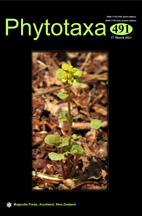Abstract
Paspalum comprises 350 species worldwide and is the largest genus of Poaceae in Brazil (211 species). The reticulated evolutionary pattern within the informal Paspalum Plicatula Group makes it a challenging species complex to treat taxonomically. The present work aims to study the three annual species P. cordaense, P. macranthecium and P. plowmanii, characterized by spikelet morphology and anthecium appearance, supported by a comprehensive review of herbaria and fieldwork collections of all related species. When ascertaining the identity of P. cordaense, we realized that it is distinct from P. plowmanii, while these two species are closely related to P. macranthecium. These findings are supported by morphological differences and by the first report of unusual chromosome number for P. plowmanii 2n = 38, whereas the numbers in P. cordaense are 2n = 40 and in P. macranthecium 2n = 20, from previously published research. We clarify the circumscription of the three species and provide a key, descriptions, comments, illustrations, distribution maps and conservation status for all species. The lectotypification of P. cordaense is also proposed.

